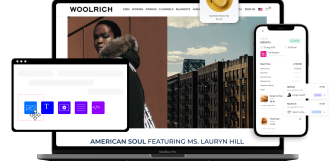How Much Does It Cost To Build A Website For A Small Business?
Your business’s website is an integral part of your branding. It’s the hub of information for customers and the face of your business if you don’t have a physical storefront.
An effective website will help your business create interest from prospective customers and hopefully generate new leads, making it a great return on investment. But how much should you pay for something that’ll make you money?
We uncover the key elements that business owners need to include in their website, the different ways to acquire a website, and answer the important question: how much does it cost to build a website for a small business?
Price of setting up a website
There are a few options for creating a website. Depending on how much time you have, your eye for design, and your budget, you may want to consider the following options.
Hire a professional website designer or builder
If you want to go down the professional route, decide if you’d like to work with an agency, or a freelance website designer, or builder.
If you hire a professional, you’re saving a lot of time on the trial and error of website building. It can seem like the preferred option for those who don’t have much technical ability, or an eye for design.
Professional website builder Tárik Quintans says “You should use a web designer if you are willing to pay a premium and if your business requires a unique approach. Having a web designer guarantees that everything you need is going to be on brand and have a distinctive look” [4].
However, there are many drawbacks to using a professional service. The first negative is the cost, hiring someone to build a website can cost thousands. On average, for a basic 5-page website with no eCommerce integrations, it can cost up to £1000 for website design alone. This doesn’t include ongoing monthly fees for maintenance, updates, and changes, technical support, hosting, domain registration, and reservation.
Another major issue with hiring somebody to create your website is that you’ll depend on them for all modifications. What would usually be a quick fix is left in the hands of the professional’s availability, which can really slow down operations if your website encounters a problem.
Use a DIY website builder
Website builders trump hiring a professional since they are the more affordable option. In some instances, it’s free to use website builders to create microsites (websites with one page only). While it’s highly recommended to create a fuller, more user-friendly website with better functionality, start-ups might choose to make a microsite simply so they can have an online presence. Epos Now provides this solution for free.
Using a website builder is also great because it allows business owners to create and upload a ready-to-go website within hours. If you have your content and imagery ready to go, you can make use of handy drag and drop features, or take advantage of free templates to achieve a stylish and sophisticated site. You’ll have a free creative license, and make edits and changes as often as you like for no additional cost. Epos Now’s website builder offers these design functions, as well as custom layout widgets, media and business widgets.
Advanced features are also available - just because you’re building the website yourself doesn’t mean it has to be basic. You can also:
- Include multiple language options to reach international audiences (55+ languages available)
- Free SSL certificate
- Create unlimited web and landing pages
- Set up automated secure backups
- Delve into developer mode for a finely tuned building and maintenance process
- Use a custom CSS
- Access free images, 100+ font styles and built-in photo editor
- Select how elements appear on desktop, tablet, or mobile - or automate this process and let the website builder configure how your page will appear on different devices
Epos Now’s website builder costs £10 a month. Read more about our Epos Now Online.
Core elements for every business website
The cost of producing and running a website varies greatly depending on what type of website you want, and the purpose it’s supposed to fulfill. There are some key elements that all business websites should have:
Contact information
Even if you don’t have a brick-and-mortar storefront that customers can visit, it’s important to include information on how they can reach you. Contact information that you need to include for maximum credibility and reachability include:
- Telephone number(s)
- Address including an embedded Google Maps map
You should also include your opening hours. If you’re an online-only retailer, include the times that customers can reach you for customer service queries. It’s also good to include a complaints form to speed up the resolution process and reduce waiting times for customers.
It’s a good idea to register your business with Google My Business, which will automatically harvest the contact information you input on your website, and make it easier for customers to find you.
Lead forms to grow your email list
Create a pop-up form or a form on your homepage where customers are encouraged to enter their name and email address for marketing purposes in return for a discount on future purchases. Doing so will allow you to retain customer contact details and add them to your mailing or telemarketing list, where you can send exclusive discounts, sales reminders, or personalised communications about the latest updates in your business.
It’s a great way to drive repeat business that also appeals to the customer, as they’re happy to receive a discount. Sending frequent communication will help you stay fresh in the minds of customers, thus bringing them back to your website more frequently, and boosting sales.
Adaptable layout
Your website should look good and be easy to navigate regardless of screen size or device type. In 2021, 55% of internet users access the web through their mobile, vs 42% on laptops or PC [1]. So, you’ll want a site that works well on a range of devices.
Generally speaking, a small-mid-sized business should have around 10-30 well-crafted pages of content and information [2]. Most modern website builders or agencies will be able to create a layout that is adjusted to the user’s device for optimised view and functionality.
Blog
Having a blog section on your website can bring amazing results. Blogs are a fantastic way to drive organic traffic to your website, thus increasing your exposure, and attracting more customers. Why? Because companies who create unique content blogs get 97% more links to their websites than websites that don’t. Also, 77% of internet users read blogs [3].
In order to write engaging blogs, make sure to include content that other people will want to link to. Write about things relevant to your industry and topics directly related to your products and services. Focus on search engine optimisation and include some keywords that customers might search for when shopping for your product. For example, if you sell commercial kitchens, you may want to write blogs about the 10 most essential kitchen appliances that restaurants should purchase before opening.
Restaurant website must-haves
Show customers what they expect to see when visiting your restaurant website: an up-to-date online menu. Hopefully, a customer’s main draw to your restaurant will be your delicious food, so it’s important to showcase this through an online menu that customers can browse before they arrive. Include any allergen information, prices, and maybe even your daily specials and photos of your food to entice more customers.
Give customers more ways to engage with your restaurant by integrating Epos Now’s Order & Pay system. This allows you to use your branded website to take bookings, display promotions, and offer delivery and collection services.
Order & Pay enables you to import your menu and create a fully-customisable profile containing important information such as nutritional values and prices. These prices are also amendable, allowing businesses with more freedom to run special promotions and limited-time sales or happy hours.
Order & Pay can support three new options for customers alongside the traditional restaurant experience. These are delivery, click and collect, and tableside ordering. It offers a completely contactless dining experience where customers scan a barcode or enter a URL, browse through your digital menu, then pay remotely. Processing times are extremely competitive, and all major cards are processed at one blended rate with Epos Now Payments.
This clean, straightforward user experience is sure to set your website apart from competitors and draw in a wide range of customers seeking convenient, speedy service.
Retail website must-haves
Your eCommerce website should be laid out with customer convenience in mind. A confusing layout, unappealing design, and a lack of product information are sure ways to deter customers from buying from your website. Overcome shopping cart abandonment by being creative with your website.
Photos are an incredibly important aspect of your website if you sell products. If you own a clothes website, make sure to include details such as the model’s measurements, available sizing, a specific sizing chart with measurements. One tip for increasing sales is to offer similar product suggestions.
You’ll also want to include customer reviews, since 63% of customers are more likely to buy a product if there are user reviews available to read [5].
Get started with Epos Now Online to make your business website dreams a reality today.




